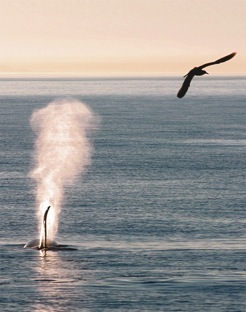Orcas listen for their dinner, study finds
Whales identify their favourite meal, chinook salmon, through sonar echoes
Resident killer whales know the precise sound of their favourite dinner, according to a new study by a team of Canadian and U.S. researchers.
Orcas like their fish dinners fat and greasy, which means their prey of choice is chinook salmon, and scientists have discovered the whales can identify a juicy chinook at up to 100 metres.
John Ford, marine mammal scientist at the Department of Fisheries and Oceans’ Pacific Biological Station, said it is well known that killer whales have a sophisticated echolocation system for finding prey, but scientists have been mystified as to how they can identify a chinook surrounded by sockeye.
“We know they like the larger chinook, but they also take the two- and three-year olds, which are the same size as the sockeye,” he said.
Now it appears the secret is in the swim bladder, an organ that controls the buoyancy of the fish, said marine ecologist John Horne of the School of Aquatic and Fisheries Science at the University of Washington, Seattle.
Horne is an author of the study presented at a meeting of the Acoustical Society of America in Florida this week. He said his team bounced recorded replicas of whale echolocation clicks off tethered sockeye, coho and chinook salmon to see what patterns emerged.
“We were looking at how killer whales perceive the fish,” he said.
The sonar echoes differ because the swim bladder on a chinook salmon is half the size of other species, and the swim bladder is responsible for most of the reflected sound energy, the study found.
Scientists now know how the whales transmit the clicks and the shape of the echo coming back from the target fish, but little is known about how the whales then interpret the information, Horne said. In addition to their built-in sonar systems, there are probably also learned skills, Horne said.
“It is the same as someone interested in picking blackberries. You get a sense of when the berries are ripe, what areas they are in and how they grow,” he said.
The research may help to develop a system for more accurately calculating fish populations, Horne said.
“And if we understand a little more about how [the whales] are foraging, it may help us understand the predator/prey interaction.”
Noise from marine traffic has been fingered as one reason the endangered southern resident killer whale population is in difficulty. Studies show that some noises, such as heavy rain on the water, reduce the whales’ foraging capacity.
Most boat traffic noise is at a lower frequency than that used by killer whales, Horne said.
“But how loud does the noise have to be at a cocktail party before you can’t hear the conversation?”
This year, chinook are in short supply, some whales are showing signs of malnourishment and there have been two unexpected deaths of breeding females in the southern resident pods. Therefore there is a push to find out why the whales are not switching their menu.
Historically, chinook would have been available year round, whereas pinks and sockeye come into the range for only a couple of months, Ford said.
“They are very much creatures of tradition. They do eat halibut and ling cod, but chinook is their preferred prey. We don’t know what constraints there are on their ability to switch prey,” he said.
